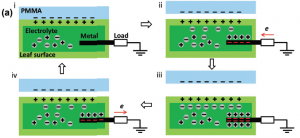Could the tree in your backyard be used to charge your smartphone? When leaves flap in the breeze, they harness the kinetic energy from the wind. While the amount of energy required for a single leaf to flap is by no means large, there are an awful lot of leaves on a tree.
The harnessing of small amounts of kinetic energy, is a task particularly well suited to triboelectric devices. These devices make use of the fact that all materials have a unique affinity for electrons. As a consequence, when one material is pushed into contact with a second, different material, a small electric current is generated.

Schematic of the leaf based triboelectric generator
If the natural movement of leaves could be used to bring them repeatedly into close contact with a material that possessed appropriate properties, then through the principles of triboelectricity, useful electric current could be generated.
In order to maximize the amount of current that a triboelectric device can generate, the careful selection of materials is crucial. In a recent work, Ning Wang, Zhong Lin Wang, Xia Cao and co-workers, do just that.
They conducted a series of experiments in which electrodes were attached to leaves and these leaves were vibrated against various plastics. The resulting electric currents and voltages were measured and compared. One of the combinations with the best results, used the leaf of the Hosta tree and the polymer, PMMA.
The Hosta leaf device was stable for a number of days. It was able to power a panel of LED lights (see video below), and in 8 minutes it was able to charge a capacitor that was used to drive an electronic temperature sensor. These promising results suggest that leaves might indeed be a useful material in the construction of triboelectric generators.

















